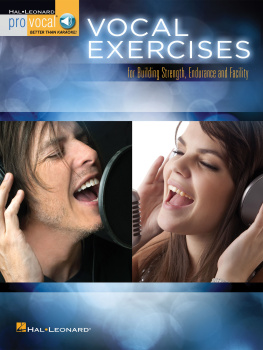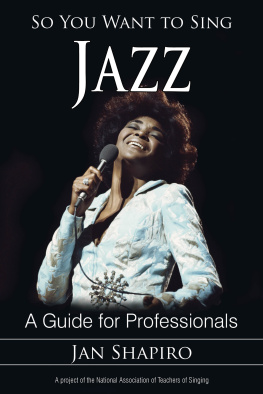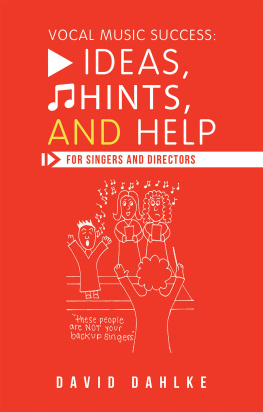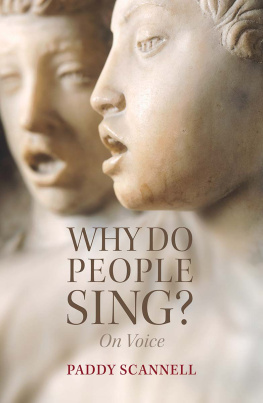Learning to Sing
A Transformative Approach to Vocal Performance and Instruction
by Jennifer Hamady
Jennifer Hamady 2011-2012
www.jenniferhamady.com
ISBN: 9780988464902
Chapter One
Introduction
For over fifteen years, I have had the privilege and pleasure of performing and teaching in the field of music at the professional level. During that time, I published my first book, The Art of Singing: Discovering and Developing Your True Voice, which not only discusses my experiences as a singer and a vocal coach, but also shares my thoughts on the proper approach to training vocalists and their voices.
The desire to capture my ideas about vocal instruction and execution stemmed from years of noting a vast chasm in many singers between intellectual understanding of vocal technique and performance outcome. This gap between knowing and doing seemed further expanded by emotional issues directly and peripherally related to voice production and performance. In fact, an inverse relationship often existed between the intensity of conscious intellectual and emotional investment in singing well and the ability to do so.
These areas of inquiry intellectual, emotional, and somatic have traditionally been perceived and treated as distinct concepts. Voice teachers and instructors of pedagogy focus on the comprehension of vocal technique. Psychologists and therapists deal with the myriad emotional issues that arise in the study and practice of the performing arts. Vocal coaches and directors concern themselves with performance outcome.
On the surface, this segregated treatment makes sense. Given the mastery of their specializations, it seems logical that these professionals would focus largely, if not entirely, on their specific areas of expertise, leaving others to deal with what appear to be associated or even unrelated matters.
Unfortunately, this compartmentalized approach rarely leads to a collective resolution. Vocal technique that is theoretically comprehended but not consistently manifested is just as ineffective and common as a highly skilled singer who crumbles in the face of performance anxiety. Both are akin, as a non-musical reference, to emotional and psychological issues that are understood, but unable to be shifted or resolved.
By addressing intellectual, emotional, and somatic concerns in specific and simultaneous ways, however, significant change in vocal ability is not only possible, but predictable. Whats more, the cognitive and emotional strongholds that once prevented progress both related to music and not unravel as well.
In these chapters, Ill distinguish this integrated approach that I have developed in my practice, beginning by addressing the three areas of inquiry the mind, emotions, and the body and their common, individual roles in the vocal learning and performing contexts. Ill then explore how to access the powerful and transformative interplay between them, followed by discussing the applicability of this approach for achieving optimal outcomes in other areas of learning and life.
Chapter Two
Intellect
The Unqualified Advocate
The first issue in the disparity between vocal knowing and vocal doing relates to the intellects trouble translating information in a way that can be wholly integrated into somatic expression. Indeed, the best explanations of technique by teachers and conscious understanding of them by students often do little to help singers incorporate these facts into predictable and effortless physical action.
Its not that the efforts of the teachers or students are lacking. It is that the intellect and its messenger language are simply not designed to understand and command, respectively, what is first and foremost a reflexive physical engagement.
As a non-musical point of reference, consider the processes of walking, talking, and standing up. While the conscious mind knows that these actions are possible and predictable, and has an awareness that they are occurring, it makes no attempts to actively engage, manage, or technically understand the intricacies of their functioning. In these instances, the physical-first processes are allowed to occur unbothered and unchecked.
For an experience of what would be an intellect-led course of action in these areas, try instructing someone precisely how to walk, talk, stand up, or to sit down. What you will find is that the conscious mind has tremendous difficulty pinpointing, in both directing and describing, the myriad muscular movements and engagements required to achieve these physical outcomes. If we want to stand, we simply stand; attempts at explanations generally prove to be exercises in frustration and futility.
So it is with singing. Just as we are able to speak without a conscious thought every day, so too do our singing voices function automatically. Certainly the mind is able to initiate, observe, and make modifications to the process as it does with speech; just as we can choose to begin a sentence, to speak more loudly, to imitate someone, or to put on an accent, so too may we choose to utilize more resonance, to increase our volume, to straighten a tone, or to shift into a different vocal register. Yet, in speaking and singing alike, these choices when effective manifest to a large extent on their own; we do not consciously implement them muscle by muscle.
The automatic design and nature of the voice, both in singing and speaking, may be better understood by considering the mechanism of breath support. The muscles responsible for inhalation and voiced, supported exhalation are too numerous, varied in placement, and intricate in functioning to consciously command in their entirety. Whats more, much of the system is also reflexive in its engagement, meaning that we are unable to directly activate aspects of it.
The diaphragm is an excellent case in point. Enabling inhalation, this dome-shaped muscle below the lungs engages automatically (thus, our ability to breathe while sleeping). During our waking hours we can certainly observe that the diaphragm is engaging, optimize the conditions for its functioning through mental and physical relaxation, and even assist the respiration process by actively taking in air. Still, we remain unable to deliberately cause it to independently engage.
To make matters more complicated, we are also unable to actually feel the diaphragm, along with other aspects of the vocal mechanism. This is thanks to proprioception a form of internal physical perception related not to the feeling and nerve-based orientation with which were familiar on the outside of our bodies, but rather, to a spatial sense of orientation based upon stimuli within the neuromuscular apparatus and body itself.
Learning
In spite of these and other factors that prevent us from consciously engaging, holistically controlling, and even feeling aspects of the vocal mechanism, many still approach singing in precisely this intellectual manner. The discussion of actively engaging the diaphragm, for example, is common in current training programs, academic methodologies, and voice publications around the globe.
There are a number of reasons why the intellect has been elevated to a role of such supreme power in the current voice training paradigm, including the introduction of music to high school and university curricula. Yet the folding of the vocal arts into the academic model did more than provide new opportunities for students. It necessarily, if not unintentionally, required the teaching methodology to conform to the current education and instruction standards as well.
Unfortunately, realizing the physical engagement of singing is distinct from the study of musics academic aspects (for which the intellect is a good fit). The latter model traditionally involves, as it does in non-music classrooms, a primarily unidirectional transfer of cognitive, fact-based information from teacher to student. Given that it is the mind that is first and foremost being addressed, this transfer also implies a passive physicality on the part of the learner, rather than the participatory action so necessary to both comprehend and integrate certain and certainly physical types of knowledge.
Next page










